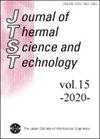环境温度对单个煤粉颗粒燃烧过程的影响
IF 0.9
4区 工程技术
Q3 THERMODYNAMICS
引用次数: 2
摘要
在煤粉燃烧过程中,煤颗粒穿过由扩散火焰形成的陡峭的温度梯度。这个温度梯度影响粒子的温度。由于脱挥发过程中的物质随颗粒升温速率的变化而变化,本研究通过实验研究了现场温度和高温区域停留时间对单个煤颗粒火焰结构的影响。通过改变层流逆流的入口速度和氧浓度来控制停留时间和温度梯度。采用放大双色热分析法了解火焰结构及火焰与颗粒温度的时间序列。结果表明:氧气浓度的升高使挥发分燃烧温度升高,火焰直径增大,挥发分燃烧持续时间延长;随着流速的增加,炭的燃烧温度降低。最大有效火焰直径随挥发分燃烧温度的升高而线性增加,与颗粒大小无关。这表明火焰干扰距离增加。随着挥发分燃烧温度的升高,最大火焰直径单调增加。稀释剂对单颗粒煤的点火延长了挥发分在含氧燃料和煤颗粒中的持续时间。模拟结果表明,在模拟全氧燃烧环境下的炭燃烧时,必须考虑co2气化反应。Köser等人对单个煤颗粒进行了高度重复的OH-LIF测量。他们使用了层流反应器,提供了一个热的富氧废气环境。10khz时OH分布的时间分辨成像允许识别反应后和燃烧后区域,并可视化煤颗粒在燃烧过程中的时间演变。这些研究表明,燃烧温度的升高。相互交流。它们都随着野外条件的变化而变化。因此,本研究的目的是明确停留时间和现场温度同时对煤颗粒火焰结构和温度的影响。用惰性气体氮稀释的o2浓度和流速改变了现场温度和停留时间。本研究测量了煤粉燃烧过程中煤烟温度、颗粒温度和颗粒直径的时间序列。本文章由计算机程序翻译,如有差异,请以英文原文为准。
Effects of ambient temperature on the combustion processes of single pulverized coal particle
In the pulverized coal combustion, coal particles cross over a steep temperature gradient formed by a diffusion flame. This temperature gradient affects the particle temperature. This study has experimentally investigated effects of field temperature and residence time in high-temperature regions on the flame structure of single coal particles, since the substances of the devolatilization process varied due to the particle heating rate. The inlet velocity and the oxygen concentration of a laminar couterflow vary to control the residence time and the temperature gradient, respectively. A magnified two-color pyrometry was carried out to understand flame structure and the time series of flame and particle temperature. The results showed that the increase of oxygen concentration raises the volatile matter combustion temperature and flame diameter, and prolongs duration of the volatile matter combustion. The char combustion temperature decreases as the flow velocity increases. The maximum effective flame diameter increases linearly with increasing volatile matter combustion temperature regardless of particle size. This suggested an increase in flame interference distance. The maximum flame diameter increases monotonically with increasing volatile matter combustion temperature. the diluent the ignition of single-particle coal prolongs the duration of volatile matter an with a Hencken burner in an oxy-fuel and of coal particles. The simulation showed that it is essential to consider the CO 2 gasification reaction when simulating char combustion in an oxy-fuel combustion environment. Köser et al. performed highly repeated OH-LIF measurements on single coal particles. They used a laminar flow reactor that provided a hot oxygen-rich exhaust gas environment. Time-resolved imaging of the OH distribution at 10 kHz allowed to identify post-reaction and post-combustion zones and visualize the time evolution of coal particles during combustion. These studies show that a an increase in combustion temperature. interact with each other. Both of them change due to changes in field conditions. Therefore, the aim of this study is to clarify the effects of residence time and field temperature on the flame structure and temperature of the coal particle simultaneously. The temperature of the field and the residence time were changed by the O 2 concentration diluted with the inert gas nitrogen and the flow velocity. This study measured the time-series soot temperature, particle temperature, and particle diameter during pulverized coal combustion.
求助全文
通过发布文献求助,成功后即可免费获取论文全文。
去求助
来源期刊
CiteScore
2.30
自引率
8.30%
发文量
0
审稿时长
5 months
期刊介绍:
JTST covers a variety of fields in thermal engineering including heat and mass transfer, thermodynamics, combustion, bio-heat transfer, micro- and macro-scale transport phenomena and practical thermal problems in industrial applications.

 求助内容:
求助内容: 应助结果提醒方式:
应助结果提醒方式:


